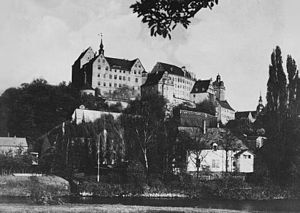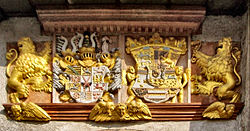
Colditz Castle
About this schools Wikipedia selection
This selection is made for schools by a children's charity read more. SOS Children has looked after children in Africa for forty years. Can you help their work in Africa?
Colditz Castle is a castle in the town of Colditz near Leipzig, Dresden, and Chemnitz in the state of Saxony in Germany ( 51°7′50.82″N 12°48′26.94″E). Used as a workhouse for the indigent and a mental institution for over 100 years, it became notorious as Oflag IV-C, a prisoner-of-war camp for "incorrigible" Allied officers who had repeatedly escaped from other camps.
History
The original castle
In 1046, Henry III of the Holy Roman Empire gave the burghers of Colditz permission to build the first documented settlement at the site. In 1083, Henry IV urged Markgraf Wiprecht of Groitzsch to develop the castle site, which Colditz accepted. In 1158, Emperor Frederick Barbarossa made Thimo I "Lord of Colditz", and major building works began. By 1200, the city around the market was established. Forests, empty meadows, and farmland were settled next to the pre-existing slavic villages Zschetzsch, Zschadraß, Zollwitz, Terpitzsch and Koltzschen. Around that time the larger villages Hohnbach, Thierbaum, Ebersbach and Tautenhain also emerged.
In the Middle Ages, the castle played an important role as a watchtower for the German Emperors and was the centre of the Reich territories of the Pleißenland (anti- Meißen Pleiße-lands). In 1404, the nearly 250-year rule of the dynasty of the Lords of Colditz ended when Thimo VIII sold Colditz Castle for 15,000 silver marks to the Wettin ruler of the period in Saxony.
As a result of family dynastic politics, the city of Colditz was incorporated in the Margravate (county) of Meißen. In 1430, the Hussites attacked Colditz and set city and castle on fire. Around 1464, renovation and new building work on the Castle were carried out by Prince Ernst, who died in Colditz Castle in 1486. Under Frederick the Wise and Johann the Gentle, Colditz was a royal residence of the Electors of Saxony.
The rebuilt castle
In 1504, the servant Clemens the baker accidentally set Colditz on fire, and the city hall, church, castle and a large part of the city went up in flames. In 1506, reconstruction began and new buildings were raised around the rear castle courtyard. In 1523, the castle park was turned into one of the largest zoos in Europe. In 1524, rebuilding of the upper floors of the castle began. The castle was reconstructed in a fashion that corresponded to the way it was divided up—into the cellar, the royal house and the banquet hall building. There is nothing more to be seen of the original fortified castle, where the present rear castle is located, but it is still possible to make out where the original divisions were (the Old or Lower House, the Upper House and the Great House).
The structure of the castle was changed under the long reign of the elector Augustus of Saxony (1553–1586), and the complex was reconstructed into a Renaissance style castle from 1577 to 1591, including the portions that were still in the gothic architectural style. Architects Hans Irmisch and Peter Kummer supervised the further restoration and rebuilding. Later, Lucas Cranach the Younger was commissioned as an artist in the Castle.
During this period the portal at what is known as the church house was created in 1584, made of porphyry and richly decorated in the mannerist style by Andreas Walther II. It was at this time that both the interior and the exterior of "the Holy Trinity" castle chapel that links the cellar and royal house with one another were redesigned. Shortly thereafter, the castle became an administrative centre for the Office of Colditz and a hunting lodge. In 1694, its then-current holder, Augustus the Strong, began to expand it, resulting in a second courtyard and a total of 700 rooms.
The modern castle

In the 19th century, the church space was rebuilt in the neo-classic architectural style, but its condition was allowed to deteriorate. The castle was used by Frederick Augustus III, Elector of Saxony as a workhouse to feed the poor, the ill, and persons under arrest. It served this purpose from 1803 to 1829, when its workhouse function was taken over by an institution in Zwickau. In 1829, the castle became a mental hospital for the "incurably insane" from Waldheim. In 1864, a new hospital building was erected in the Gothic Revival style, on the ground where the stables and working quarters were previously located. It remained a mental institution until 1924.
During World War II, the castle was used as a Prisoner of War camp (see POW). No escapes were made at this time. When the Nazis came to power in 1933, they turned the castle into a political prison for communists, homosexuals, Jews, and other "undesirables". It was not until 1939 that allied prisoners were housed there. In April 1945, US troops entered Colditz town and, after a two-day fight, conquered the castle on April 16.
In May 1945, the Soviet occupation of Colditz began. Following the Yalta Conference it became a part of East Germany. The Soviets turned Colditz castle into a prison camp for local burghers and non-communists. Later, the castle was a home for the aged and nursing home, as well as a hospital and psychiatric clinic. For many years after the War, forgotten hiding spots and tunnels were found by repairmen, including a radio room set up by the British POWs, which was then "lost" again only to be re-discovered some ten years later.
The current castle
Today the castle and the church space require a significant amount of refurbishment and restoration. The last users moved out on August 1, 1996, and since then the castle has been almost empty except for the occasional visitor. The "Gesellschaft Schloss Colditz e.V." (the Castle Colditz historical society), founded in 1996, has its offices in a portion of the administration building in the front castle court.
The castle has been renovated and turned into a museum with visits showing some of the escape tunnels built by prisoners of the Oflag during World War II.
During 2006 and 2007, the castle continues to undergo a full restoration and refurbishment, sponsored largely by the state of Saxony. In the near future, part of the castle will remain an escape museum, with the former Kommandantur (German quarters) becoming a youth hostel and vacationers' hotel.
Colditz Castle as a mental institution
For nearly a hundred years, between 1829 and 1924, Colditz was a sanitarium, generally reserved for the wealthy and the nobility of Germany. The castle thus functioned as a hospital during a long stretch of massive upheaval in Germany, from slightly after the Napoleonic Wars destroyed the Holy Roman Empire and created the German Confederation, throughout the lifespan of the North German Confederation, the complete reign of the German Empire, throughout the First World War, and until the beginnings of the Weimar Republic. Between 1914 and 1918, the castle was home to both psychiatric and tuberculosis patients, 912 of whom died of malnutrition.
Colditz Castle was also home to several notable figures during its time as a mental institution, including Ludwig Schumann, the second youngest son of the famous composer Robert Schumann, and Ernst Georg August Baumgarten, one of the original inventors of the airship.
Colditz Castle as Oflag IV-C
After the outbreak of World War II the castle was converted into a high security prisoner-of-war camp for officers who had become security or escape risks or who were regarded as particularly dangerous. Since the castle is situated on a rocky outcropping above the Mulde river, the Germans believed it to be an ideal site for a high security prison.
The larger outer courtyard, known as the Kommandantur, had only two exits and housed a large German garrison. The prisoners lived in an adjacent courtyard in a 90 ft (27 m) tall building. Outside, the flat terraces which surrounded the prisoners' accommodation were constantly watched by armed sentries and surrounded by barbed wire. Although known as Colditz Castle to the locals, its official German designation was Oflag IV-C and it was under Wehrmacht control.
Although it was considered a high security prison, it boasted one of the highest records of successful escape attempts. This could be due to the general nature of the prisoners that were sent there; most of them had attempted escape previously from other prisons and were transferred to Colditz because the Germans had thought it to be escape-proof. One lavish scheme even included a glider that was kept in a remote portion of the castle's attic, although it was never used because Germany surrendered to the Allies before the scheduled date of the planned escape.





